- Recent Updates
- Colpoy's Bay
- Colpoy's Bay Introduction
- Spragge's Hill
- The Kalbfleisch House
- The Kalbfleisch Dock
- The Kalbfleisch Marina
- Whicher's Sawmill
- The Wrecks Near Whicher's Mill
- Frame's Falls and John Wood's Grist Mill
- Albemarle Street
- Hughenden and Whicher's Store
- The Community Hall
- The Forest Home Hotel
- The Colpoy's Bay Schoolhouse
- The Colpoy's Bay Church
- Edgehill Cemetery
- Colpoy's Bay From the Air
- A Glimpse of the Past
- Wiarton
- Berford Street
- Berford St. Part 2
- Berford St. Part 3
- Wiarton Harbour
- Bluewater Beach
- Caframo Ltd. and Wiarton Cement Works
- Wiarton Beet Sugar Factory
- Wiarton's Hotels
- Wiarton's Schools
- Wiarton's Banks
- Grand Trunk Railway Station
- The Wiarton Fish House
- The Wiarton Fish Hatchery
- Wiarton's Berford Theatre
- The Wiarton Woolen Mills
- Wiarton's Furniture Industry
- Wiarton's Hospital
- Wiarton's War Memorial
- Wiarton's Town Hall
- Wiarton's Newspapers
- Wiarton's Grist & Flour Mills
- Wiarton's Sawmill Industry
- Wiarton's Gateway
- Connecting Passages
(Links) - Present-day Map
of Colpoy's Bay - Colpoy's Bay
Lot Map (1870) 
Wiarton Timeline- Present-day Map
of Wiarton - Bibliography
- About the Author
- Site Map
(use if menu doesn't work) - Tell me your impressions!
The Wiarton Fish House
Aside from the lumber trade (sawmills and furniture production), Wiarton's second most important founding business was, not surprisingly, fishing.
With the arrival of the Grand Trunk Railway and construction of the main wharf taking place in 1882, two men named James McKay and James Clark (both of Goderich) decided to set up a fish distribution centre in Wiarton's natural harbour. In February of 1883, the Wiarton fish house first opened its doors.
A couple of years later, the business, still run by McKay and Clark, became the central point of packing, freezing and shipping for what was known as the Buffalo Fish Company. In June of 1886 the fish house received an upgrade including additional freezers (giving them the largest in the province) and a new steam engine. By summertime the following year, Wiarton's fish house was shipping 150 000 pounds of fish per week on 5 steamships with the entire operation (fish house, ships, etc.) employing 125 people. In August of that year, they also boasted a mechanical hoist (that ran off the power of a berthed steamship) to lift cargo from the ship to the shore. (As an interesting note, Clark and McKay also constructed the Arlington Hotel in 1887.)
The success of the operation warranted a major expansion in 1891 that was expected to double the number of shipments out of Wiarton (primarily by attracting business currently working out of Collingwood), cementing the Wiarton fish house's status as the largest operation in Ontario. By May of that year, the Clark and McKay fish house had been rebuilt to stand 300 x 50 feet containing four fridges (i.e. ice houses) with a capacity of 500 tons, two steam engines (one of which operated the hoist) and 25 direct employees. Drawing from the stock of ice harvested from Colpoy's Bay during the previous winter, the operation was consuming 20 tons of ice per day for use in freezing, refrigerating and shipping. It was also during 1891 that John Macauley, a man who's name is still synonymous with the Wiarton fish house, was first appointed manager. By 1894, the Buffalo Fish Company was shipping 3 million pounds of fish per year, with Wiarton standing at the heart of the operation!
In 1898 the Buffalo Fish Company was taken over by the Booth Fisheries Corporation of Chicago, with the Wiarton fish house serving as the headquarters for the Canadian operations which went by the name of "Dominion Fish Company". (The Dominion Fish Co. had been established in 1882 in Manitoba.)
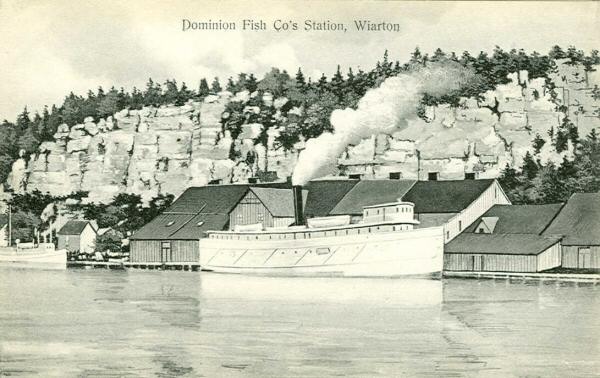
Figure W12A: Dominion Fish Company (about 1905)
Figure W12A above shows the Wiarton fish house in its prime, situated along the shoreline, beneath the limestone cliffs. Figure W12B gives a similar view along with a starkly contrasting image taken in 2023 from the same point of view.


Figure W12B: Dominion Fish Company (about 1905) and a similar view in 2023.
The peak of the Wiarton fish house continued for 20 years until the Dominion Fish Company decided to move its headquarters to the larger port of Owen Sound in 1918. The year 1920, which saw the company renamed to Booth Fisheries Canadian Company, Ltd., brought further setbacks when the Wiarton fish house caught fire. The damage was significant enough to warrant a complete rebuilding of the fish house on a somewhat smaller scale. Nevertheless, Wiarton's fishing business continued strongly throughout the 1920s.
Figure W12C shows a spectacular view from this period, in which you can see the Wiarton harbour from the cliffs above the fish house. Note how the railway lines ran directly behind the fish house where Bayview St. now runs.
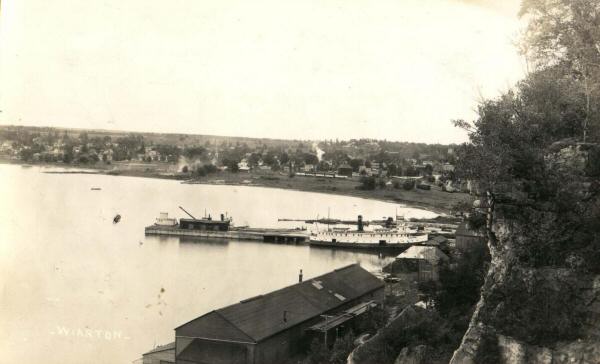
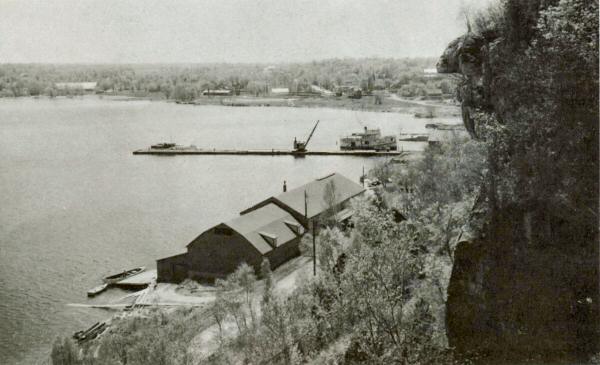
Figure W12C: The Wiarton fish house from the cliffs (c. 1920s, 1958)
However, the most serious blow to Wiarton's fishing business (and indeed fishing on all of the Great Lakes) was on its way and it came on a much broader scale. The Lamprey Eel, which had existed in the St. Lawrence River and Lake Ontario, was introduced to the other Great Lakes through the Welland Canal around 1921. It had arrived in Lake Huron (including Georgian Bay) by 1932. The eel feasted on the lakes' trout population, seriously slowing the fish trade. This fact, in combination with the generally weak economic environment (which was in the midst of the Great Depression) no doubt contributed to the closure of Booth Fisheries in 1935.
At that time, the Wiarton fish house was taken over by John Macauley who changed the name officially to Wiarton Fish House. He continued to run the operation, as far as I can tell, until 1941 at which time the fish house took another name, "Wiarton Fish Company", which it held until its final closure in 1966, 83 years after it had first opened. The bottom image of Figure W12C, above, gives a great view from the cliffs behind the fish house in 1958, 8 years before its closure. Note the interesting barn-shaped addition to the east end of the fish house, the relatively pristine roof the entire building sported at the time and the complete lack of industry along Bluewater beach in the distance. In a very short time, the train tracks would be removed and the last shipment of fish would leave the Wiarton fish house.

Figure W12D: The former Wiarton fish house (about 2000).
In later years, the the former fish house structure served as part of Wiarton's marina, but it just barely lived to see the turn of the millennium. Figure W12D above shows the former Wiarton fish house shortly before its demolition in the winter of 1999-2000. By then the building was showing its age...it was a run-down echo of a time long-since passed.
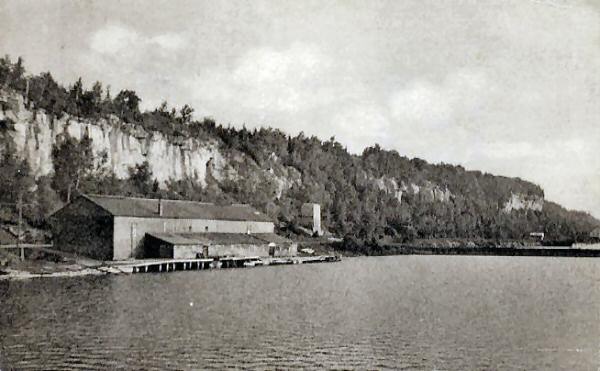
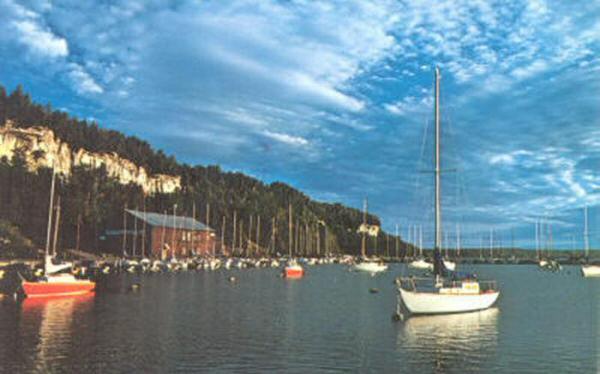

Figure W12E: The Wiarton fish house (late 1930s, 1980s and 2023),
The top image of Figure W12E above shows the 1920 incarnation of the fish house as it stood in the 1930s. The effects of the lamprey eel had left the waters eerily devoid of fishing boats. By the 1980s, the fish house was a relic that seemed out of place amidst the multitude of pleasure yachts in the Wiarton Marina. A similar view from 2023 shows Wiarton's busy, modern marina, but no trace of the former fish house which would have been at the middle-left of the picture. Its former location now serves as a parking lot for the marina (and in the winter time, the yachts themselves while in storage!).

